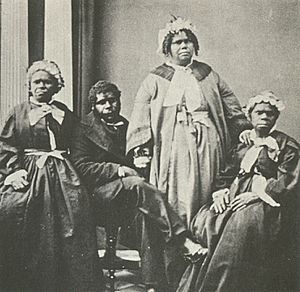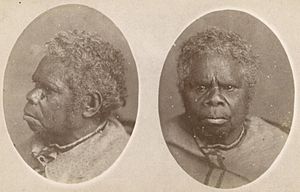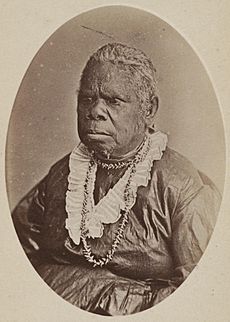Truganini facts for kids
Truganini (also known as Lallah Rookh; around 1812 – 8 May 1876) was an Aboriginal Tasmanian woman. She was one of the last people who spoke the Tasmanian languages. She was also one of the last people who were entirely of Aboriginal Tasmanian heritage.
Truganini grew up near the D'Entrecasteaux Channel and Bruny Island. Many of her family members died during the Black War, a time of conflict. From 1829, she worked with George Augustus Robinson. He was an official for the government of Van Diemen's Land (now Tasmania). She helped him as a guide and shared information about Aboriginal language and culture. In 1835, Truganini and most other Aboriginal Tasmanians who were still alive moved to Flinders Island. This island is in the Bass Strait. Robinson had set up a special mission there. However, this mission was not successful and caused many problems for the Aboriginal Tasmanian people.
In 1839, Truganini and sixteen other Aboriginal Tasmanians went with Robinson to the Port Phillip District. This area is now part of Victoria. She soon stopped working with him. About two years later, she and four other Aboriginal Tasmanians, including Tunnerminnerwait, became outlaws. They were involved in conflicts that led to the deaths of two whalers. This started an eight-week chase and resistance. All five were accused of murder. Tunnerminnerwait and another man were found guilty and executed. Truganini and the others were sent back to Tasmania. In 1847, she moved to the Oyster Cove settlement. This place was close to where she was born. There, she continued some parts of her traditional way of life.
By the 1860s, Truganini and William Lanne became subjects of scientific interest. People wrongly thought they were the last "full-blood" Aboriginal Tasmanians. After Truganini died in Hobart in 1876, her body was dug up by the Royal Society of Tasmania. Her skeleton was shown to the public at the Tasmanian Museum until the 1940s. In 1976, her remains were given back to the Aboriginal community and cremated. Some of her remains were sent to the Royal College of Surgeons of England. They were returned to Tasmania in 2002.
Contents
Understanding Truganini's Name
Truganini's name has been spelled in many different ways. Some of these spellings include Trukanini, Trugernanner, Trugernena, Truganina, and Trucaninny. She was also widely known by the nickname Lalla Rookh.
Truganini's Early Life
Truganini was born around 1812 on Bruny Island. This island is known as Lunawanna-alonnah in the local language. It is located south of Hobart, the capital of Van Diemen's Land. The D'Entrecasteaux Channel separates it from the Tasmanian mainland. Her father, Mangana, was the chief of the Bruny Island people. In the local Bruny Island language (Nuennonne), the word truganina means a type of plant called the grey saltbush.
When Truganini was young, her people still followed their traditional culture. However, European settlers soon arrived and changed their way of life. In 1824, Lieutenant-Governor George Arthur came to Van Diemen's Land. He started two plans to deal with the growing conflict between settlers and Aboriginal people. One plan offered rewards for capturing Aboriginal adults and children. The other tried to make friends with Aboriginal people to get them to live in camps. This effort began on Bruny Island, where the conflicts were not as bad as in other parts of Tasmania.
Moving to New Places
Life on Flinders Island
In 1830, Robinson moved Truganini and her husband, Woorrady, to Flinders Island. Most of the last surviving Tasmanian Aboriginal people, about 100 of them, also moved there. The goal was to protect them by keeping them separate. However, many people in the group died from illnesses like influenza. In 1838, Truganini and sixteen other Aboriginal Tasmanians helped Robinson set up a settlement for Aboriginal people from the mainland at Port Phillip.
Time in Victoria
After living in and around Melbourne for about two years, Truganini joined Tunnerminnerwait and three other Tasmanian Aboriginal people. This group became outlaws. They were involved in robberies and shootings with settlers near Dandenong. This led to a long chase by the authorities. The outlaws moved to Bass River and then Cape Paterson. The group was eventually captured, and Truganini was injured.
Life at Oyster Cove
Truganini and most of the other Tasmanian Aboriginal people were sent back to Flinders Island a few months later. In 1856, the few Tasmanian Aboriginal people who were still alive at the Flinders Island settlement, including Truganini, moved to Oyster Cove. This settlement was south of Hobart.
According to The Times newspaper, in 1861, only fourteen people were left at Oyster Cove. A report from the Colonial Office stated: "14 persons, all adults, aboriginals of Tasmania, who are the sole surviving remnant of ten tribes. Nine of these persons are women and five are men...". By 1873, Truganini was the only person left from the Oyster Cove group.
Truganini's Death and Burial
Truganini died in May 1876. She was buried at the former Female Factory in Cascades, a suburb of Hobart. Before she died, Truganini asked the government officials for a respectful burial. She wanted her ashes to be scattered in the D'Entrecasteaux Channel.
However, her wishes were not fully followed. Within two years, her skeleton was dug up by the Royal Society of Tasmania. It was put on public display in the Tasmanian Museum in 1904 and stayed there until 1947. Finally, in April 1976, close to 100 years after her death, Truganini's remains were cremated and scattered as she had wished. In 2002, some of her hair and skin were found in a collection at the Royal College of Surgeons of England. These were returned to Tasmania for burial.
Truganini's Important Legacy
Truganini is often mistakenly called the last speaker of a Tasmanian language. However, The Companion to Tasmanian History mentions three Aboriginal Tasmanian women named Sal, Suke, and Betty. They lived on Kangaroo Island in South Australia in the late 1870s and lived longer than Truganini. There were also Tasmanian Aboriginal people living on Flinders and Lady Barron Islands. Fanny Cochrane Smith (1834–1905) lived 30 years longer than Truganini. In 1889, she was officially recognized as the last Tasmanian Aboriginal person, though some thought she was of mixed heritage. Smith recorded songs in her native language. These are the only audio recordings that exist of an original Tasmanian language.
Historian Cassandra Pybus wrote a book about Truganini in 2020. Pybus says that Truganini's fame as the "last of her people" has hidden the important roles she played in Tasmanian and Victorian history during her life. Pybus states that Truganini "lived through a psychological and cultural shift more extreme than most human imaginations could conjure; she is a hugely significant figure in Australian history."
Truganini Place in the Canberra suburb of Chisholm is named in her honor.
Truganini in Art and Stories
Visual Art and Objects
In 1835 and 1836, artist Benjamin Law made two busts (sculptures of heads and shoulders) of Truganini and Woorrady in Hobart Town. These sculptures have recently caused some debate. In 2009, members of the Tasmanian Aboriginal Centre protested when these works were put up for auction. They argued that the sculptures were unfair and suggested that Aboriginal people had disappeared. They also felt the sculptures ignored the experiences of Tasmania's remaining Aboriginal populations. Representatives asked for the busts to be returned to Tasmania and given to the Aboriginal community. They were successful in stopping the auction.
Artist Edmund Joel Dicks also created a plaster bust of Truganini. This sculpture is now in the collection of the National Museum of Australia.
In 1997, the Royal Albert Memorial Museum in Exeter, England, returned Truganini's necklace and bracelet to Tasmania.
Music and Books
- "Truganini's Dreaming" is a song written by Bunna Lawrie. He is the main songwriter and singer of the Australian Aboriginal band Coloured Stone. The song was on their 1986 album, Human Love. This album won the Best Indigenous Release at the ARIA Music Awards of 1987.
- Truganinni is a play about her life by Melbourne writer Bill Reid. It was first performed at the Union Theatre, University of Melbourne on 21 April 1970. George Whaley directed it, and Jan Hamilton played Truganinni.
- "Truganini" is a song by Midnight Oil. It is from their 1993 album Earth and Sun and Moon. This song talks about Truganini and also about what Midnight Oil saw as Australia's environmental and social problems.
- In Mudrooroo's novel Doctor Wooreddy's Prescription for Enduring the Ending of the World, one of the main characters is Trugernanna. This is a fictional version of Truganini.
- A steamship named Truganini sailed in the South Seas in 1886. It visited Papua New Guinea.
- A racehorse named "Truganini" ran in Britain in the early 1900s. Another horse named "Trucanini" started racing in 2012.
- The unfair treatment of Truganini is mentioned in Yuval Harari's book Sapiens: A Brief History of Humankind.
- "Truganani" is the name of a song by Troy Kingi. It is from his 2019 album Holy Colony Burning Acres.
See also
 In Spanish: Truganini para niños
In Spanish: Truganini para niños
- Black War
- Doctor Wooreddy's Prescription for Enduring the Ending of the World
- Tunnerminnerwait, a leader and resistance fighter
Images for kids









